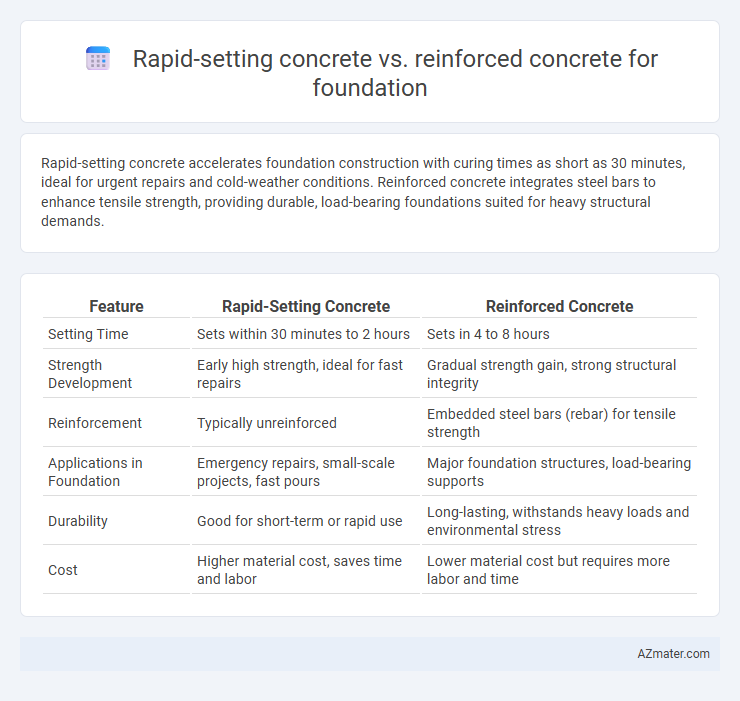Rapid-setting concrete accelerates foundation construction with curing times as short as 30 minutes, ideal for urgent repairs and cold-weather conditions. Reinforced concrete integrates steel bars to enhance tensile strength, providing durable, load-bearing foundations suited for heavy structural demands.
Table of Comparison
| Feature | Rapid-Setting Concrete | Reinforced Concrete |
|---|---|---|
| Setting Time | Sets within 30 minutes to 2 hours | Sets in 4 to 8 hours |
| Strength Development | Early high strength, ideal for fast repairs | Gradual strength gain, strong structural integrity |
| Reinforcement | Typically unreinforced | Embedded steel bars (rebar) for tensile strength |
| Applications in Foundation | Emergency repairs, small-scale projects, fast pours | Major foundation structures, load-bearing supports |
| Durability | Good for short-term or rapid use | Long-lasting, withstands heavy loads and environmental stress |
| Cost | Higher material cost, saves time and labor | Lower material cost but requires more labor and time |
Introduction to Foundation Concrete Types
Rapid-setting concrete is designed to achieve high early strength within hours, making it ideal for time-sensitive foundation projects requiring quick load-bearing capacity. Reinforced concrete incorporates steel bars or mesh, providing enhanced tensile strength and durability essential for supporting heavy structural loads in foundational applications. Selecting between these foundation concrete types depends on project timelines, load requirements, and environmental conditions.
What is Rapid-Setting Concrete?
Rapid-setting concrete is a fast-curing material designed to achieve high early strength within hours, making it ideal for urgent repairs and time-sensitive foundation projects. Unlike traditional reinforced concrete, which incorporates steel rebar to enhance tensile strength and durability, rapid-setting concrete focuses on rapid hydration using specialized cement blends and additives. This quick turnaround reduces downtime and accelerates construction schedules but may require careful consideration of load-bearing capacity and long-term performance in foundation applications.
Understanding Reinforced Concrete
Reinforced concrete combines concrete's high compressive strength with steel's tensile strength, making it ideal for foundations requiring durability and load-bearing capacity. The embedded steel reinforcement bars (rebar) enhance resistance to cracking and structural stresses, ensuring long-term stability under various load conditions. Unlike rapid-setting concrete, reinforced concrete cures more slowly but provides superior strength and resilience critical for foundational integrity.
Key Material Differences
Rapid-setting concrete incorporates special chemical admixtures like calcium sulfoaluminate to accelerate hydration, allowing it to harden within minutes to hours, ideal for fast repairs or time-sensitive projects. Reinforced concrete combines Portland cement, coarse and fine aggregates, water, and embedded steel reinforcement bars (rebars) to significantly enhance tensile strength and durability under load. The primary material difference lies in rapid-setting concrete's formulation for speed of set, whereas reinforced concrete emphasizes structural strength through steel integration.
Speed of Construction and Curing Time
Rapid-setting concrete achieves initial set within 20 to 40 minutes, significantly reducing curing time compared to traditional reinforced concrete, which typically requires 28 days to reach full strength. The accelerated curing of rapid-setting concrete enables faster construction schedules and earlier load application, making it ideal for projects with tight time constraints. Reinforced concrete, while slower to cure, provides enhanced structural integrity through embedded steel reinforcement that manages tensile stresses effectively.
Structural Strength and Durability
Rapid-setting concrete offers accelerated curing times, achieving initial structural strength within hours, which is advantageous for fast-track foundation projects requiring early load-bearing capacity. Reinforced concrete combines concrete's compressive strength with embedded steel rebar to significantly enhance tensile strength and overall durability, making it ideal for foundations subjected to heavy loads and dynamic stresses. While rapid-setting concrete ensures quick structural stability, reinforced concrete provides superior long-term resilience against cracking, corrosion, and environmental degradation.
Load-Bearing Capabilities
Rapid-setting concrete offers faster curing times, enabling quicker construction schedules but generally exhibits lower load-bearing capacity compared to reinforced concrete. Reinforced concrete combines concrete's compressive strength with steel reinforcement's tensile strength, resulting in superior load-bearing capabilities ideal for heavy foundation applications. Engineered foundation designs often favor reinforced concrete for structural integrity under dynamic and heavy loads, whereas rapid-setting concrete suits temporary or less demanding load conditions.
Cost Implications and Budget Considerations
Rapid-setting concrete significantly reduces labor and formwork costs due to its quick curing time, enabling faster project completion and early load application, which can lower overall construction expenses. Reinforced concrete, while typically more expensive upfront because of steel reinforcement materials and longer curing periods, provides enhanced structural strength and durability, potentially reducing long-term maintenance and repair costs. Evaluating the balance between immediate budget constraints and long-term structural requirements is essential when choosing between rapid-setting and reinforced concrete foundations.
Application Suitability for Foundations
Rapid-setting concrete offers excellent application suitability for foundations requiring fast curing times, such as emergency repairs or projects with tight schedules. Reinforced concrete is ideal for foundations needing enhanced structural strength and load-bearing capacity due to its embedded steel reinforcement. Choosing between the two depends on project timelines, load requirements, and soil conditions influencing foundation stability.
Choosing the Right Concrete for Your Foundation
Rapid-setting concrete offers the advantage of faster curing times, making it ideal for projects requiring quick load-bearing capacity, while reinforced concrete provides superior tensile strength and durability due to embedded steel bars. When choosing the right concrete for your foundation, consider project timelines, soil conditions, and structural load requirements to determine whether rapid-setting's speed or the enhanced stability of reinforced concrete is more suitable. Proper evaluation ensures a foundation that balances immediate utility with long-term performance and resilience.

Infographic: Rapid-setting concrete vs Reinforced concrete for Foundation
 azmater.com
azmater.com